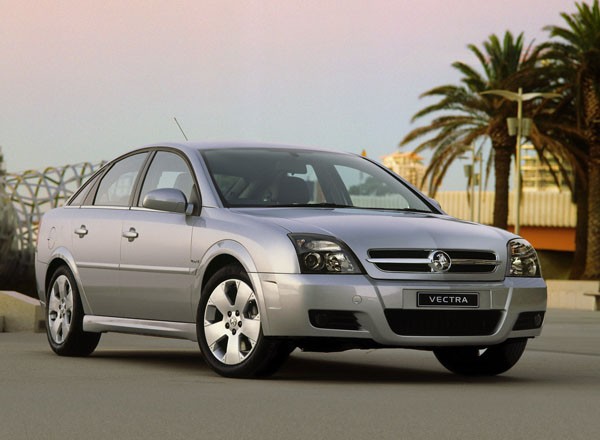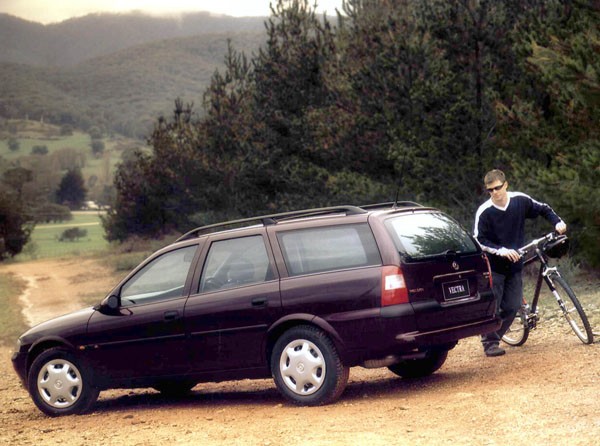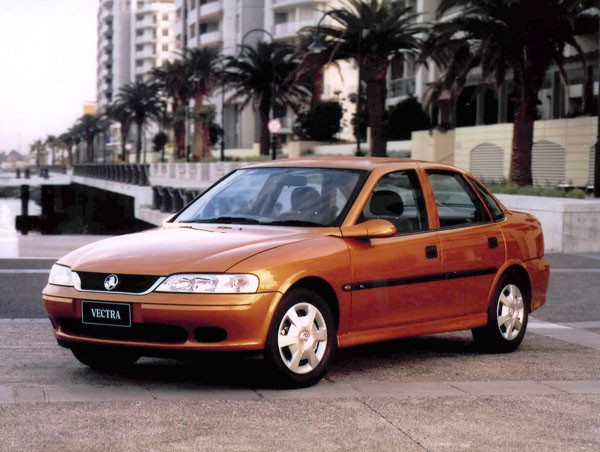
Holden Vectra was designed and built by Opel, the German division of General Motors. Some models were assembled by Holden in Australia with some changes to suit Australian driving conditions as well as Australian drivers’ tastes.
The Vectra was medium sized when launched in Australia in June 1997. From March 2003 it became significantly larger, being close to the first generation Holden Commodores, (1979 to 1988) in size.
Vectra became increasingly expensive and sales slowed significantly, forcing Holden to cut prices in 2004 and again in 2005. Things didn’t improve so the Vectra was discontinued in 2006.
Vectra’s road grip is impressive thanks to its European heritage and this semi-sporty machine is happy to corner hard and doesn’t complain when asked to change direction mid-corner. It generally retains its composure pretty well on rough Aussie country roads and remains stable on corrugated tracks that can upset the ride of Asian machines in this class.
Vectra was initially imported from June 1997 as a four-door sedan or a five-door hatchback. A five-door station wagon was added to the line-up when local assembly began in August 1998. Wagons were not particularly popular and were taken off the market at the end of 2000, though some may not have been registered until the first months of the new millennium in 2001. Strictly speaking the latter should be called 2000 models and priced accordingly, but this far down the track that’s barely relevant.
Interior room is good in the front but rear legroom prior to the 2003 model is marginal if the front seats are set well back. From then on the larger car is pretty good in the back seat. The front seats are well-shaped and provide good support during hard cornering.
Vectra’s boot volume is good in all versions, with the wagon having a nicely shaped load area that can carry bulky items.
Initially the lower cost Vectra models used a 2.0-litre four-cylinder engine. Its capacity was increased to 2.2 litres with the change to Australian manufacture in 1998. This four-cylinder unit has good torque output over a large spread of revs. However, it is not as refined as it should be.
The topline Vectra CD (hatchback only) used a 2.5-litre V6. That engine is typically European in its setup so doesn’t have a lot of grunt at lower revs. Rather it’s aimed at slow, around town work and high-speed motorway cruising. Road test it yourself to see if it suits.
The larger-bodied 2003 Holden Vectra has a choice between a 2.2-litre four-cylinder engine and a 3.2-litre V6. Interestingly, the V6 was built by Holden and exported to the European factory for use worldwide.
Most Vectra V6 models came only with four-speed automatic, until the ZC model was introduced in 2003, when it moved up to the extra refinement and performance offered by a five-speed auto. The rest of the Vectra range gives buyers the choice between a four-speed automatic and a five-speed manual.
These Holden Vectras are modern cars and therefore relatively complicated in design, so all but basic servicing and repairs are best left to the professional mechanic. If you do your own work make sure you have access to a workshop manual. Don’t tackle any safety-related work.
Vectra has the advantage of being backed by the huge Holden dealer network that’s widespread. Some spare parts may not be stocked in remote areas, though they can usually be shipped there in a day or so. Spares for older models may no longer be available from Holden dealers, but parts recyclers can usually help.
Parts prices are around average for a European car of this type. Meaning they are often more expensive than for the locally built Holdens, though not excessively so.
Insurance costs are generally on the low to medium side in their range. We know of no insurance company that discriminates between four and six-cylinder engines in premiums.
WHAT TO LOOK FOR
Look for scuffing on the left-hand tyres and scrapes on the wheels. These are quite big cars and some sloppy drivers rub the tyres against kerbs while parking. Those who can’t park may not be too good at driving either…
Paint that isn’t an exact match from the old to the new paint indicates a former respray. Check for poor quality repairs in hard to see areas such as under the bonnet and in the boot.
The cabin and load area generally stands up well to rough usage, but Vectras are getting on in years and could be in a sad way. Major trim repairs can cost more than big mechanical repairs so be sure to get a quote before agreeing to buy the car.
Check the engine starts virtually immediately and the four-cylinder idles reasonably smoothly. The six should be all but imperceptible when it’s idling.
Look for signs of repaired crash damage. This can most easily be spotted by checking for mild wrinkles in the panels, look along the length of the panel against a good light.
Engines should pull without hesitation even when cold, run without any rattles and not puff smoke from the exhaust under acceleration.
Be wary of a manual gearbox that baulks and/or is noisy during changes. A fast three-two downshift is usually the first to suffer if there is a problem.
CAR BUYING TIP
Check the service record of any car, as professionals are all but guaranteed to do a better job than enthusiastic amateur mechanics.










